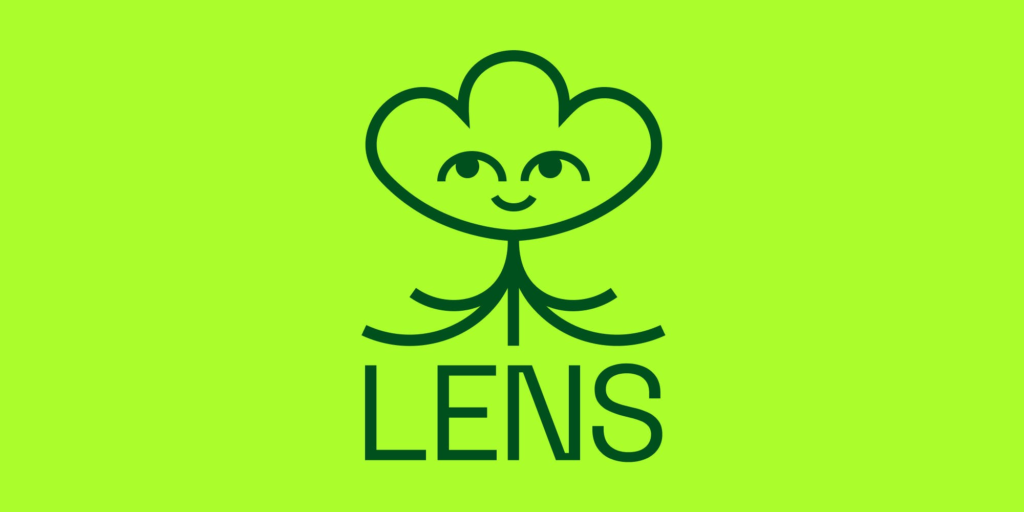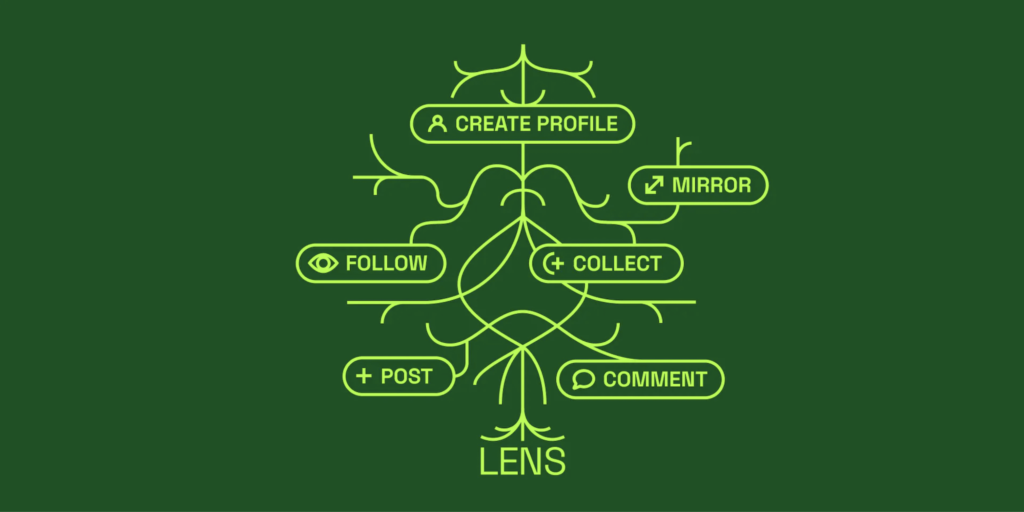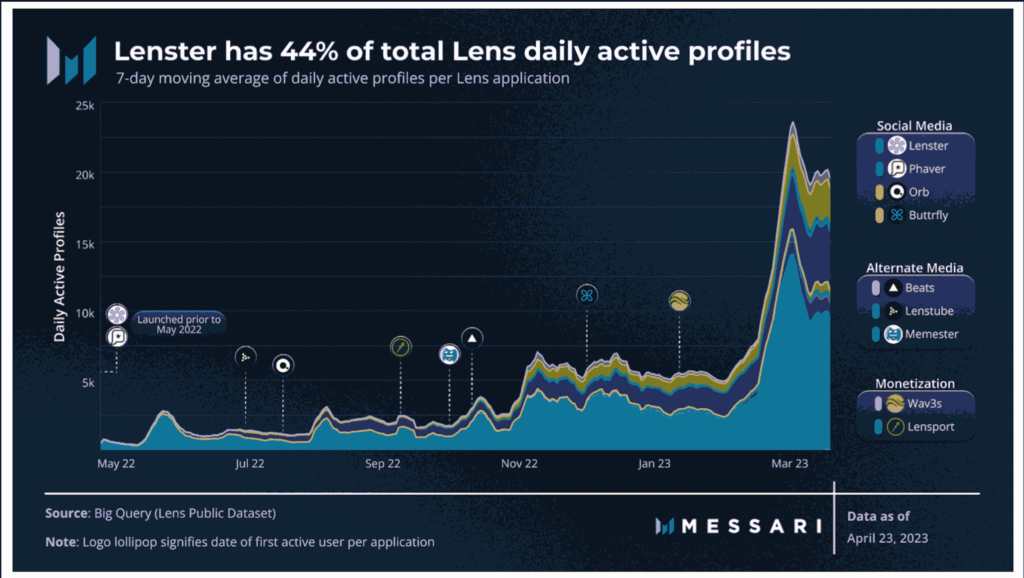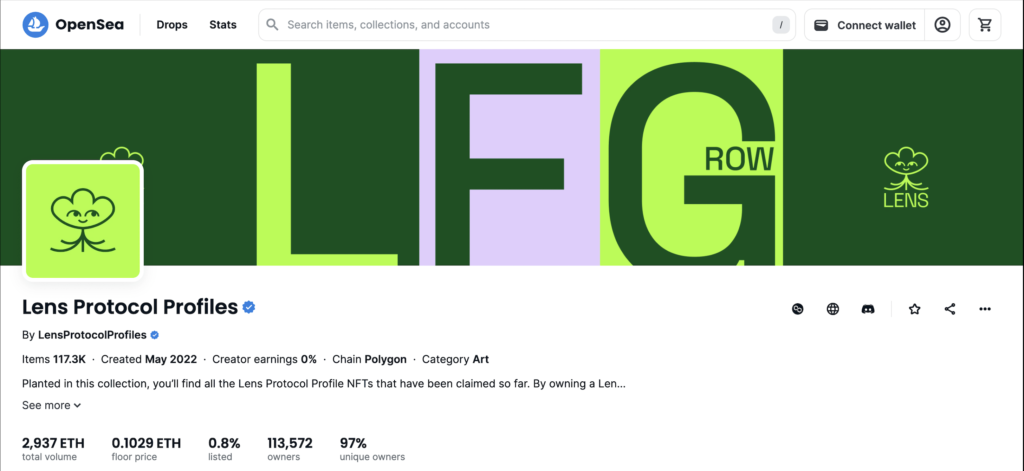Contemplating data privacy, security, proprietorship, and monetization within the existing social media landscape often stumbles upon challenges precipitated by the conventional centralized systems which remain under the supervision of a distinct entity or authority. As a response to these impediments, Lens Protocol emerged, encapsulating a decentralized social media construct, wherein users’ confidentiality, data sovereignty, and economic advantages are comprehensively governed by the individual user. This treatise delves into the intricacies of Lens Protocol, explicating its operational mechanics, comparative advantages, and its contemporary applications within the social media sphere.
Article Summary
- ⛓️ The Lens protocol is built on the Polygon blockchain, which uses a proof-of-stake (PoS) foundation. Lens embodies decentralization and provides solutions for comprehensive control over digital identity, encompassing aspects of privacy, data ownership and monetization within social media platforms.
- 📱 Renowned social media interfaces constructed on the Lens Protocol framework, such as Lenster, Phaver, and Orb, proffer innovative and singular functionalities by capitalizing on the robust capacities of blockchain technology and Web3. Via these multifarious interfaces, Lens has successfully logged a revenue upwards of US$5.54 million.
- 📸 Lens Protocol has innovated a feature referred to as ‘Profile NFT’, which constitutes NFTs with distinctive nomenclatures, concluding with the suffix “.lens”. These Profile NFTs function as identities and encapsulate post engagements, mirror actions, commentary, and additional created content.
- 💵 To acquire a Lens Protocol Profile NFT, prospective users can transact via OpenSea, with price points commencing from 200 USDC.
What is Lens Protocol?

The Lens Protocol is a Web3 social graph constructed on the Polygon Proof-of-Stake (PoS) blockchain technology. The Lens Protocol reconfigures the formerly centralized concept of social media into a decentralized one, wherein the protocol devised by Lens Protocol enables creators to independently construct their social media platforms and ensures that the content produced is fully controlled by each respective owner.
Employing such technology, Lens Protocol facilitates the creation of a more open and transparent social media landscape built atop blockchain technology, utilizing non-fungible tokens (NFTs) as assets that can represent the profile identities of its users.
Who Founded Lens Protocol?

Stani Kulechov, Founder & CEO of Aave, a Decentralized Finance (DeFi) lending protocol, is a key figure behind the creation of Lens Protocol. The inception of Lens Protocol stemmed from Kulechov’s concerns about the importance of individuals having control over their digital identities. Further, he highlighted how Web2 social media platforms do not empower individuals with the ability to manage data, maintain privacy, and monetize their data, as these functions are constrained by the applied centralized system.
“Lens Protocol has familiar social media functionalities like maintaining a profile, commenting, resharing posts, and more. However, Lens Protocol is equipped with NFTs, so users can own and control all their content,” Quoted from the Official Twitter Lens Protocol.
Kulechov established Lens Protocol in Venice, California in 2022. Lens Protocol was initially available on the Polygon Mumbai testnet, subsequently transitioning to the Polygon Mainnet in May 2022.
How Does The Lens Protocol Works?
Lens Protocol is a Web3 social graph built using a Graph Database (GBD). This database uses a graph structure to represent the relationships between individuals and communities in social networks. This structure is created as profiles are created, other user accounts are followed, content is created, and content is connected to other content.
Unlike centralized Web2 social media such as Instagram, Facebook, Twitter, TikTok, YouTube and others, Lens Protocol integrates the social graph into smart contracts and allows users to build social media platforms and communities independently. Specifically, the social graph owned by Lens Protocol is open and permissionless, allowing blockchain-based social media platforms or DApps to connect to it.
The technology behind the Lens Protocol is built on the eco-friendly Polygon blockchain, using a proof-of-stake (PoS) framework. The protocol is also compatible with crypto wallets such as MetaMask, Gnosis Safe and Argent, enabling interoperability across a variety of social media platforms.
What Makes Lens Protocol Different

Fundamentally, the features found in Lens Protocol are inspired by Web2 social media, but offer a distinctive element through the unique concept of Non-Fungible Tokens (NFTs). NFTs serve as profiles that can store all content, from comments to likes to reposts. In this way, the profile created is tied to a wallet address. Below is a more detailed explanation of the features available in Lens Protocol:
- 👤 Profile NFTs: Posts and comments are at the heart of any social media platform. With Lens Protocol, users own all the content they create because it is stored within their profile NFTs.
- 💚 Collect: Collecting posts is a native Web3 feature that serves as a method for creators to generate revenue from their content. Users can collect content from others and store it as an NFT in their wallet.
- 🔄 Mirror: Similar to Twitter’s retweet feature, mirroring refers to any publication that is re-shared. Unlike posts and comments, mirrors are not original content and therefore cannot be collected by other users. In addition, mirrors can serve as a new form of advertising by increasing profile visibility.
- 👥 Follow NFT: When a user follows a profile in Lens Protocol, they receive a Follow NFT that can be expanded by the creator and the community.
- ✅ Reactions: Similar to Web2 platforms, users can react to publications with upvotes or downvotes. Although these metrics can’t be monetized, they help users discover content.
As content creators, users have control over who can collect their published output. Lens Protocol then enables social media monetization. Of course, access to certain content requires a fee. Additionally, subscription costs can be set. This uniqueness is only made possible by the blockchain technology inherent in Web3.
Web3 Implementation to Social Media Platforms

Web3 has emerged as a new attraction due to its ability to offer profile interoperability with social media applications, thus providing direct control over personal content that can be monetized. Lens Protocol embodies this capability in several of the most popular social media platforms they own, which include:
- Lenster: A decentralized social media web application built with Lens Protocol. Lenster is known in the community as Lens’s first owned Web3 social media, serving as a means to utilize Lens Protocol and interact with the social graph. Lenster is similar to Twitter in terms of appearance and operation, but with additional support for various types of NFTs.
- Phaver: A dApp platform that combines features from Web2 and Web3 applications, where its social media activities resemble Web2 but with refinements in the form of incentives given to users from their ownership in Phaver by issuing tokens and sharing favorite content, whether blogs, tweets, and so forth.
- Orb: Orb uses Lens Protocol to build a decentralized professional social media application for professionals to the Web3 world. Orb is capable of connecting people, companies, and projects simultaneously. Orb is similar to LinkedIn but offers many exciting features, such as quizzes that provide rewards in the form of NFTs.

As can be seen from the Messari data above, among the three most popular platforms within the Lens protocol, Lenster ranks first and has seen its daily active users increase by up to 9 times in the last six months. These three platforms have managed to grow rapidly primarily due to their focus on social media-based applications. Currently, Lenster dominates the share of daily active users with 44%, followed by Phaver with 23% and finally Orb with 12%. All of these applications were developed using the Lens protocol and dominate the large number of applications built on Lens. This surge in users may be due to speculation that Lens Protocol is planning an upcoming token airdrop.
Read more: How to Get Crypto Airdrops: Tips and Projects to Watch in 2023
How to Get NFT Profiles & Potential Lens Protocol Token Airdrops

For those interested in exploring Lens Protocol further, they must obtain a Profile NFT, a unique non-fungible token ending with the suffix “.lens”. This Profile NFT serves as an identity and contains activities such as posts, mirrors, comments, and other created content. Unfortunately, free Profile NFTs were only distributed during an event on August 15, 2022.
For new users wishing to own a Profile NFT, they can purchase one via OpenSea. Here’s how:
- Buy a Profile NFT on OpenSea. Profile NFT prices start from 200 USDC.
- Earn Phaver points to have the chance to get a Profile NFT.
To obtain a Profile NFT through Phaver:
- Visit https://clique.social/provenance/phaver, and complete the tasks given. These tasks include following and contributing to Phaver and Provenance2026’s social media accounts. Both accounts will check the Twitter profiles that register and follow to see the number of followers and impressions. After completion, submit your entry. Note that this is an application process, so more frequent activity will increase your chances of making the list. The Phaver team will then send applications to Lens every week for whitelisting.
- Check if your wallet address qualifies and can be registered.
- If registered, the free Profile NFT can be accessed at https://claim.lens.xyz/.
All activities on Lens Protocol revolve around the Profile NFT, which can later be used to record activities, claim user content, and monetization.
The Future and Development of Lens Protocol

While the evolution from Web2 to Web3 is still in transition, the benefits of Web3 and blockchain for social media usage have had a significant impact. Citing data from Hootsuite, as of January 2023, the global social media user base has reached 4.76 billion users.
Imagine billions of these social media users being exposed to blockchain technology, and adopting it through the Lens Protocol. Of course, the various features of Lens Protocol can offer something interesting from social media that is not in Web2, such as interoperability, privacy, security, and direct income generation. For this reason, Lens Protocol is here to accelerate this revolution through similar projects in the social media space. Lens Protocol empowers users and gives them control and the ability to decide how social media should be built and monetized and has a major impact on the communication paradigm. Lens Protocol still has a lot of room to grow.
Overall, Lens Protocol continues to grow rapidly. As of April 2023, as quoted from the Messari report titled User Behavior and Engagement on Lens, Lens revenue reached $5.54 million, with 93% coming from Profile NFT and the rest from subscription fees, collections, and referral fees. In fact, in the last six months, revenue from creators has increased by approximately $323,000.
The room for further growth is certainly very large if Lens Protocol can attract more creators and social media users and foster a growing and profitable ecosystem for all users. Then creating new features, more targeted incentive campaigns, strategic marketing, and focusing on creators and increasing user loyalty will lead Lens Protocol to a more successful and diverse ecosystem.
Conclusion
Absolutely, Lens Protocol truly represents a breakthrough in social media by introducing a decentralized, blockchain-based concept. Leveraging NFT technology, Lens Protocol enables every user to own, control and monetize their own content. It aims to provide a solution to the issues of privacy, data ownership, and economic benefit that are often encountered on traditional social media platforms. This platform also offers several unique and interesting features such as content aggregation, mirroring (retweeting), and reactions (upvotes or downvotes).
The implementation of Lens Protocol technology in social media applications such as Lenster, Phaver and Orb shows the enormous potential of this technology to reshape the social media landscape in the future. This is evidenced by the significant growth in active users on these platforms, especially Lenster. However, in order to acquire an NFT profile on Lens Protocol, new users must make a purchase through OpenSea or earn points through Phaver. Lens Protocol’s progress demonstrates the immense potential of blockchain technology, especially in the social media space, by opening up opportunities for users to have full control over their data and content.
References
- Sasha Shilina, What is Lens Protocol, and how does it work?, Cointelegraph, accessed on 24 May 2023.
- Temitope Olantunji, What Is Lens Protocol and How Does It Solve the Problems of Web2?, Makeuseof, accessed on 24 May 2023.
- Cryptoslate, About Lens Protocol, accessed on 24 May 2023.
- Alchemy, What is Lenster?, accessed on 24 May 2023.
- Orb, Super App for Social Media, accessed on 24 May 2023.
- David Thompson, Phaver Introduces a Decentralized Social Platform That Rewards Users, Techtimes, accessed on 24 May 2023.
- Angela Wang, Lens Protocol Token Airdrop Guide: How to get a Lens profile?, accessed on 24 May 2023.
- Lens Protocol, Introducing Lens Protocol, Mirror.xyz, accessed on 24 May 2023.
- Cbinsight, About Lens Protocol, accessed on 24 May 2023.
- Bybit Learn, Lens Protocol: A Composable & Decentralized Social Network, Learn.bybit, accessed on 24 May 2023.
- Godfrey Benjamin, Aave’s Stani Kulechov Launches Social Media Platform “Lens Protocol”, Blockchain.news, accessed on 24 May 2023.
- Josh Adams, Rumor Potensi Airdrop Sukses Picu Aksi Pump Pasar Lens Protocol, Beincrypto, accessed on 24 May 2023.
- Ally Zach, User Behavior and Engagement on Lens, Messari.io, accessed on 24 May 2023.
- Docs.lens, What is Lens? 🌿, accessed on 24 May 2023.
